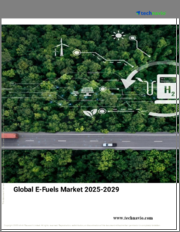
|
시장보고서
상품코드
1429283
세계의 이퓨얼(E-Fuel) 시장 : 현황 분석 및 예측(2023-2030년)E-Fuel Market: Current Analysis and Forecast (2023-2030) |
||||||
세계의 이퓨얼(E-Fuel) 시장 규모는 예측 기간 동안 CAGR 57.1%에서 강력하게 성장할 것으로 예측됩니다. 이퓨얼(E-Fuel) 업계는 지난 10년간 엄청난 성장을 이루고 있으며, 향후 수년간 더욱 급속한 성장이 예상됨에 따라 이퓨얼(E-Fuel) 시장 도입이 증가하고 있습니다. 이퓨얼(E-Fuel)은 기존의 화석연료를 대체하는 보다 지속가능하고 환경친화적인 연료이기 때문에 자동차, 화학, 항공 등의 최종사용자 업계가 이퓨얼(E-Fuel)의 주요 소비자가 되고 있습니다.
세계의 이퓨얼(E-Fuel) 시장은 지속가능한 운송에 대한 수요 증가, 기술 진보, 청정 에너지 투자 증가, 에너지 안보 배려 등 몇 가지 중요한 요인에 의해 견인되고 있습니다. 지속가능한 운송에 대한 주목이 높아지고 있으며, 이퓨얼(E-Fuel)은 운송이나 항공과 같은 전기가 어려운 분야를 탈탄소화하는 방법으로 주목받고 있습니다. 시장은 아직 초기 단계에 있으며, 이퓨얼(E-Fuel)을 소량 생산하는 공장은 몇 군데밖에 설립되지 않았습니다. 그러나 다양한 기업과 정부 조직의 급속한 투자가 이 틈새 시장을 크게 뒷받침하고 있으며 예측 기간 동안 가장 빠르게 성장하는 지속가능한 에너지 시장 중 하나가 되고 있습니다.
이퓨얼(E-Fuel) 시장은 연료 유형별로 암모니아, 합성 연료, 메탄올 등으로 나뉩니다. 합성 연료 부문은 이퓨얼(E-Fuel) 시장에서 대부분의 점유율을 획득하고 있으며, 예측기간 동안 큰 성장률을 보일 것으로 예상됩니다. 이퓨얼(E-Fuel) 프로젝트의 대부분의 성장률은 암모니아이며, 전해수소를 이용한 수소계 제품 생산의 주요 원동력은 연료로서의 잠재적 용도가 아니라 암모니아의 산업용도에서 나옵니다. 비료 산업은 암모니아가 사용되는 가장 큰 용도 중 하나입니다. e-암모니아 생산을 목표로 하는 프로젝트의 생산 능력의 약 1/4은 특히 비료 산업에서의 사용을 목표로 하고 있습니다.
신재생 에너지원을 바탕으로 이퓨얼(E-Fuel) 시장은 태양광 발전, 풍력 발전, 하이브리드 발전으로 나뉩니다. 하이브리드 부문은 이퓨얼(E-Fuel) 시장의 대부분을 차지하고 있으며 예측 기간 동안 상당한 성장률을 보일 것으로 예상됩니다. 태양광 발전은 풍력 발전에 비해 보다 많은 지역에서 도입 가능하며 신재생 에너지 중 가장 비용 효율적인 방법의 하나이기 때문에 이퓨얼(E-Fuel) 분야의 성장을 지배하고 있습니다. 세계 각국의 정부는 각 지역에서 태양에너지를 촉진하기 위해 다양한 정책과 이니셔티브를 도입하고 있습니다. IEA에 따르면 태양광 발전의 설비 용량은 2027년까지 석탄을 넘어 세계 최대가 될 전망입니다. 현재 상품 가격 상승으로 투자 비용이 상승하고 있음에도 불구하고 세계 대부분의 국가에서는 신규 발전의 선택으로서 실용 규모의 태양광 발전이 가장 저렴한 비용의 선택이 되고 있습니다.
이퓨얼(E-Fuel) 업계 시장 도입에 대한 이해를 높이기 위해 시장은 아메리카(미국, 브라질, 기타 아메리카 지역), 유럽(독일, 스페인, 영국, 기타 유럽), 아시아태평양(중국, 인도, 기타 아시아태평양) 및 기타 지역에서 세계의 존재를 기반으로 분석됩니다. 유럽은 이퓨얼(E-Fuel) 시장에서 대부분 시장 점유율을 얻고 있으며 예측 기간 동안 영향력 있는 CAGR을 나타낼 것으로 기대됩니다. 이 성장은 러시아, 독일, 스페인, 스웨덴, 노르웨이, 핀란드, 덴마크, 아이슬란드, 오스트리아, 스위스에서의 청정 에너지, 이퓨얼(E-Fuel)의 보급, 향후 플랜트 건설을 위한 자금 증가로 인한 것입니다. 독일은 다양한 이퓨얼(E-Fuel) 공장과 신재생 에너지 분야에 대한 대규모 투자로 이퓨얼(E-Fuel) 시장에서 큰 점유율을 얻고 있습니다. 이 지역은 Norsk 이퓨얼(E-Fuel) 등 다양한 이퓨얼(E-Fuel) 기업의 본사이기도 합니다. Norsk 이퓨얼(E-Fuel)은 세계 최대의 이퓨얼(E-Fuel) 제조업체로 2030년까지 2억 5,000만 리터의 이퓨얼(E-Fuel) 생산을 목표로 하고 있습니다. 이 회사는 노르웨이에 본사를 두고 항공 산업을 대상으로 합니다. 이 회사는 노르웨이의 Vefsn 지자체 Mosjoen/Nesbruket에 연간 5,000만 리터의 생산 능력을 가진 Alpha 공장의 건설을 계획하고 있으며, 2026년까지 완전 생산을 개시한다고 합니다.
이 시장에 진입하는 주요 기업으로는 Norsk E-Fuel, Sunfire GmbH, Siemens Energy, Advanced Chemical Technologies, BASF SE, Carbon Recycling International, Enerkem, Fraunhofer, OCI NV, Uniper SE 등이 있습니다.
목차
제1장 시장 서문
- 시장의 정의
- 주요 목표
- 이해 관계자
- 제한 사항
제2장 조사 방법 또는 전제 조건
- 조사 과정
- 조사 방법
- 응답자 프로파일
제3장 주요 시장 인사이트
제4장 주요 요약
제5장 세계의 이퓨얼(E-Fuel) 시장 수익(2020-2030년)
제6장 시장 인사이트 : 연료 유형별
- 암모니아
- 합성 연료
- 메탄올
- 기타
제7장 시장 인사이트 : 신재생 자원별
- 태양광
- 풍력
- 하이브리드
제8장 시장 인사이트 : 지역별
- 아메리카
- 미국
- 브라질
- 기타 아메리카
- 유럽
- 독일
- 스페인
- 영국
- 기타 유럽
- 아시아태평양
- 중국
- 인도
- 기타 아시아태평양
- 기타 지역
제9장 이퓨얼(E-Fuel) 시장 역학
- 시장 성장 촉진요인
- 시장의 과제
- 영향 분석
제10장 이퓨얼(E-Fuel) 시장 기회
제11장 이퓨얼(E-Fuel) 시장 동향
제12장 수요측 및 공급측 분석
- 수요측 분석
- 공급측 분석
제13장 밸류체인 분석
제14장 정부의 정책 및 규제
제15장 경쟁 시나리오
- Porter's Five Forces 분석
제16장 기업 프로파일
- Norsk E-Fuel
- Sunfire GmbH
- Siemens Energy
- Advanced Chemical Technologies
- BASF SE
- Carbon Recycling International
- Enerkem
- Fraunhofer
- OCI NV
- Uniper SE
제17장 면책사항
AJY 24.02.28E-fuels, also known as electrofuels, are synthetic fuels produced from renewable energy sources, such as solar or wind power, using a process called power-to-liquid (PtL). They can be in the form of gas or liquid and include e-Synfuel, e-kerosene, and e-methanol. E-fuels are considered a carbon-neutral alternative to traditional fossil fuels because the carbon dioxide emitted during their combustion is balanced by the carbon captured during their production. They can be used in existing internal combustion engines without the need for modifications, making them a potential substitute for petrol or diesel in the transportation sector. They can be blended with conventional fuels in any ratio and can be used climate-neutrally worldwide.
The E-Fuel Market is expected to grow at a strong CAGR of 57.1 % during the forecast. The E-Fuel industry experienced tremendous growth in the past decade and is further anticipated to grow rapidly in upcoming years has led to the increasing adoption of E-Fuel in the market. End-user industries such as automotive, chemical, aviation, and others are becoming the major consumers of E-fuels, as it is a more sustainable and environmentally friendly alternative to traditional fossil fuels.
The global E-fuel market is driven by several key factors, including the Rising Demand for Sustainable Transportation, Technological Advancements Increased Investments in clean energy, and Energy Security Considerations. There is an increased focus on sustainable transportation, and e-fuels are seen as a way to decarbonize hard-to-electrify sectors such as transportation and aviation. The market is still in its early stages and only a few plants have been set up which produce e-fuel in small quantities. However, the rapid investments by various companies and government organizations have given a substantial boost to the niche market making it one of the fastest-growing sustainable energy markets during the forecast period.
Based on Fuel Type, the E-Fuel Market is divided into Ammonia, Synfuel, methanol and Others. The Synfuel segment acquired a majority share in the E-Fuel Market and is expected to showcase a substantial growth rate during the forecast period. The majority growth rate of E-fuel projects is for ammonia as the main driver for the production of hydrogen-based products using electrolytic hydrogen is coming from ammonia's industrial applications instead of its potential use as a fuel. The fertilizer industry is one of the biggest applications where this ammonia is utilized. Around one-quarter of the capacity of projects aiming to produce e-ammonia specifically target its use in the fertilizer industry..
Based on Renewable Sources, the E-Fuel Market is divided into Solar PV, Wind, and Hybrid. The Hybrid segment acquired a majority share in the E-Fuel Market and is expected to showcase a substantial growth rate during the forecast period. Solar PV dominated the growth in the E-fuel sector as it can be deployed in more areas as compared to wind power and is one of the most cost-effective ways to make renewable energy. Governments worldwide have introduced various policies and initiatives to promote solar energy in their region. According to IEA, Solar PV's installed power capacity is poised to surpass that of coal by 2027, becoming the largest in the world. Despite current higher investment costs due to elevated commodity prices, utility-scale solar PV is the least costly option for new electricity generation in a significant majority of countries worldwide.
For a better understanding of the market adoption of the E-Fuel industry, the market is analyzed based on its worldwide presence in countries such as North & South America (U.S.A., Brazil, Rest of North & South America), Europe (Germany, Spain, United Kingdom, and Rest of Europe), Asia-Pacific (China, India, and Rest of Asia-Pacific), Rest of World. Europe acquired the majority market share in the E-Fuel Market and is expected to witness an influential CAGR in the forecasted period. The growth is due to the increasing funds in clean energy, the promotion of E-fuel and upcoming plants in Russia, Germany, Spain, Sweden, Norway, Finland, Denmark, Iceland, Austria and Switzerland. Germany Acquired a significant share in the E-fuel market on account of various E-fuel plants as well as huge investments in the renewable energy sector. The region is also the headquarters of various E-fuel companies such as Norsk E-Fuel. Norsk E-Fuel is one of the biggest E-fuel manufacturers in the world and aims to produce 250 million litres of E-fuel operational by 2030. Their target base is the aviation industry and the company is situated in Norway. The company is planning to build Alpha Plant in Mosjøen/Nesbruket, Vefsn Municipality, Norway with a production capacity of 50 million litres a year which is said to start complete production by 2026 and would be one of the biggest plants in the region.
Some of the major players operating in the market include Norsk E-Fuel, Sunfire GmbH, Siemens Energy, Advanced Chemical Technologies¸ BASF SE¸ Carbon Recycling International, Enerkem, Fraunhofer, OCI N.V., and Uniper SE.
TABLE OF CONTENTS
1 MARKET INTRODUCTION
- 1.1. Market Definitions
- 1.2. Main Objective
- 1.3. Stakeholders
- 1.4. Limitation
2 RESEARCH METHODOLOGY OR ASSUMPTION
- 2.1. Research Process of the E-Fuel Market
- 2.2. Research Methodology of the E-Fuel Market
- 2.3. Respondent Profile
3 MARKET KEY INSIGHTS
4 EXECUTIVE SUMMARY
5 GLOBAL E-FUEL MARKET REVENUE, 2020-2030F
6 MARKET INSIGHTS BY FUEL TYPE
- 6.1. Ammonia
- 6.2. Synfuel
- 6.3. Methanol
- 6.4. Others
7 MARKET INSIGHTS BY RENEWABLE SOURCE
- 7.1. Solar PV
- 7.2. Wind
- 7.3. Hybrid
8 MARKET INSIGHTS BY REGION
- 8.1. North & South America
- 8.1.1. United States
- 8.1.2. Brazil
- 8.1.2. Rest of North & South America
- 8.2. Europe
- 8.2.1. Germany
- 8.2.2. Spain
- 8.2.3. United Kingdom
- 8.2.4. Rest of Europe
- 8.3. Asia Pacific
- 8.3.1. China
- 8.3.2. India
- 8.3.3. Rest of APAC
- 8.4. Rest of World
9 E-FUEL MARKET DYNAMICS
- 9.1. Market Drivers
- 9.2. Market Challenges
- 9.3. Impact Analysis
10 E-FUEL MARKET OPPORTUNITIES
11 E-FUEL MARKET TRENDS
12 DEMAND AND SUPPLY-SIDE ANALYSIS
- 12.1. Demand Side Analysis
- 12.2. Supply Side Analysis
13 VALUE CHAIN ANALYSIS
14 GOVERNMENT POLICIES AND REGULATIONS
15 COMPETITIVE SCENARIO
- 15.1. Porter's Five Forces Analysis
16 COMPANY PROFILED
- 16.1. Norsk E-Fuel
- 16.2. Sunfire GmbH
- 16.3. Siemens Energy
- 16.4. Advanced Chemical Technologies
- 16.5. BASF SE
- 16.6. Carbon Recycling International
- 16.7. Enerkem
- 16.8. Fraunhofer
- 16.9. OCI N.V.
- 16.10. Uniper SE




















